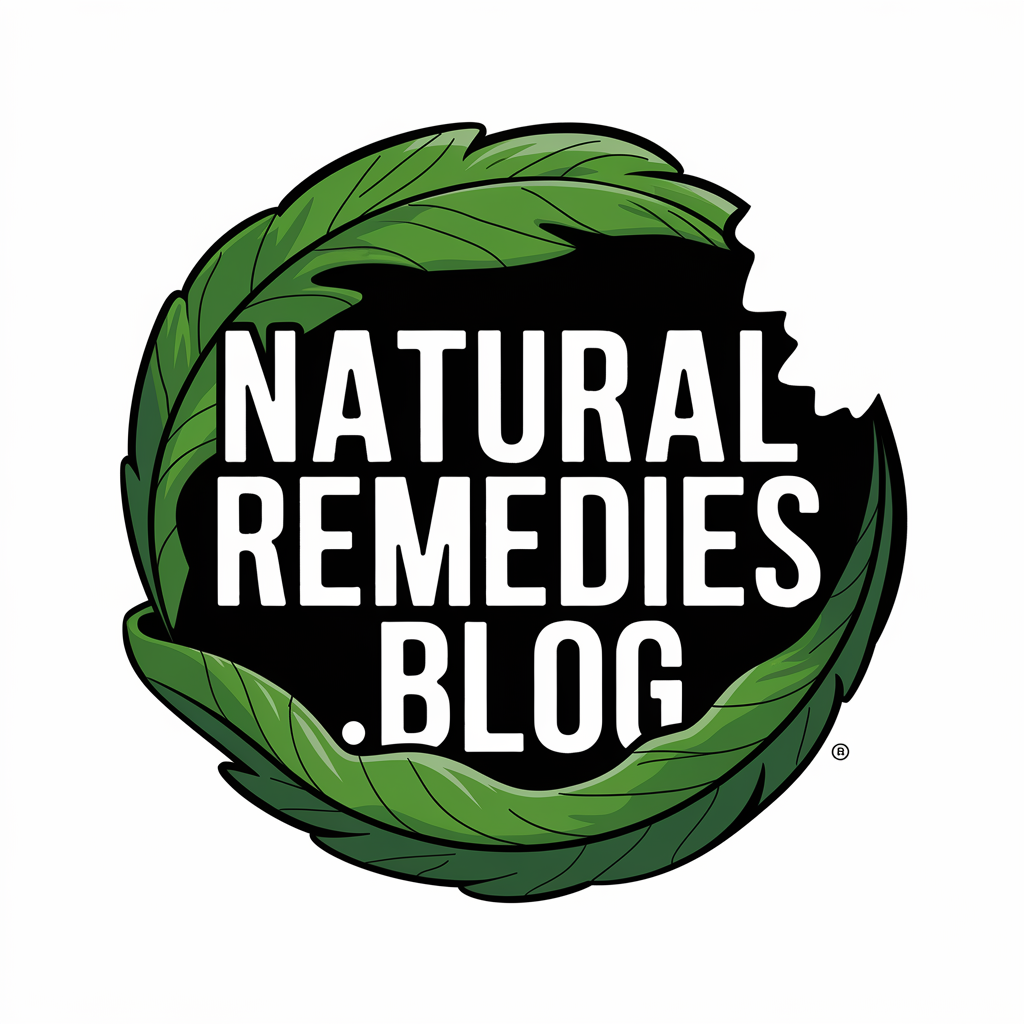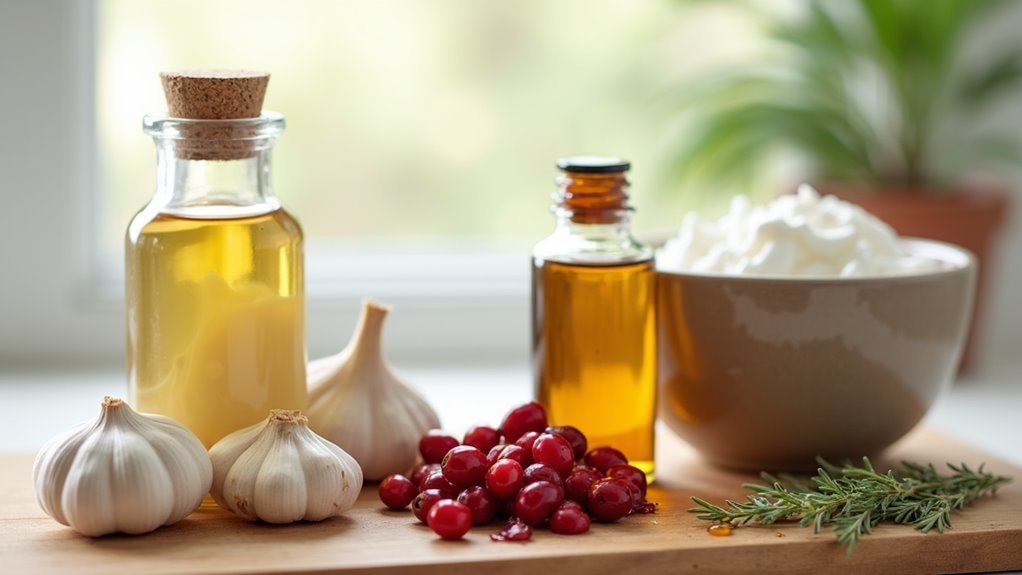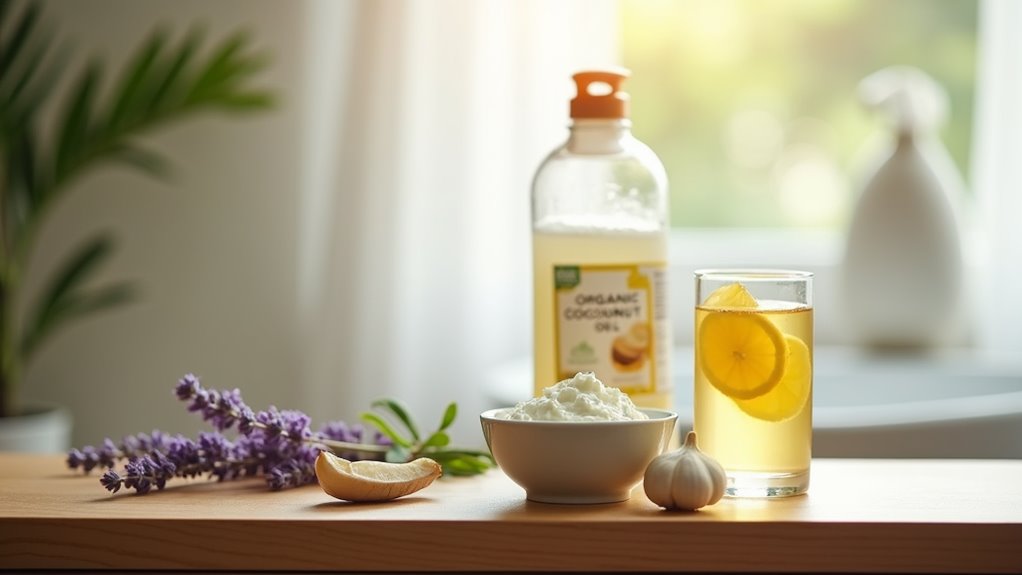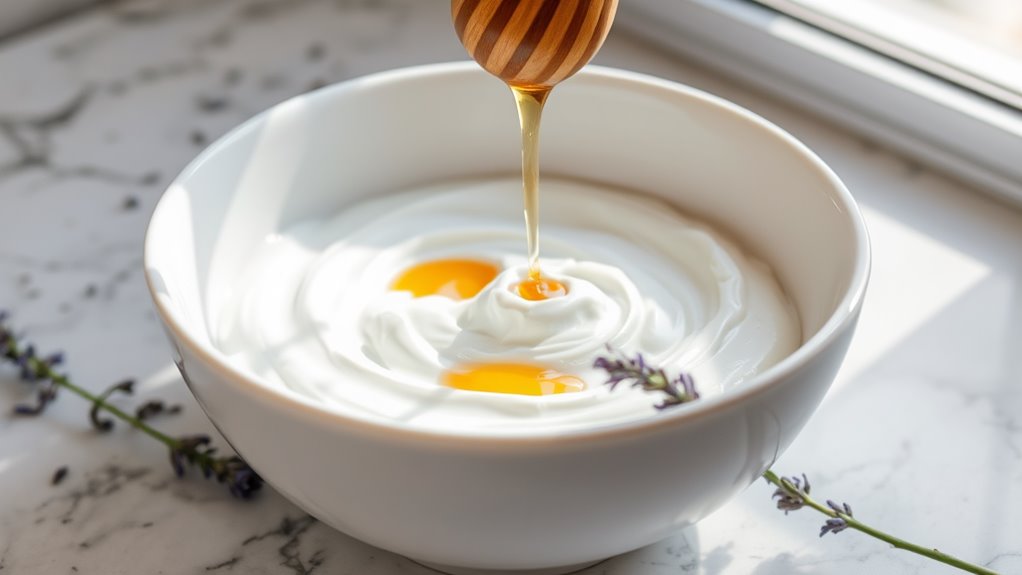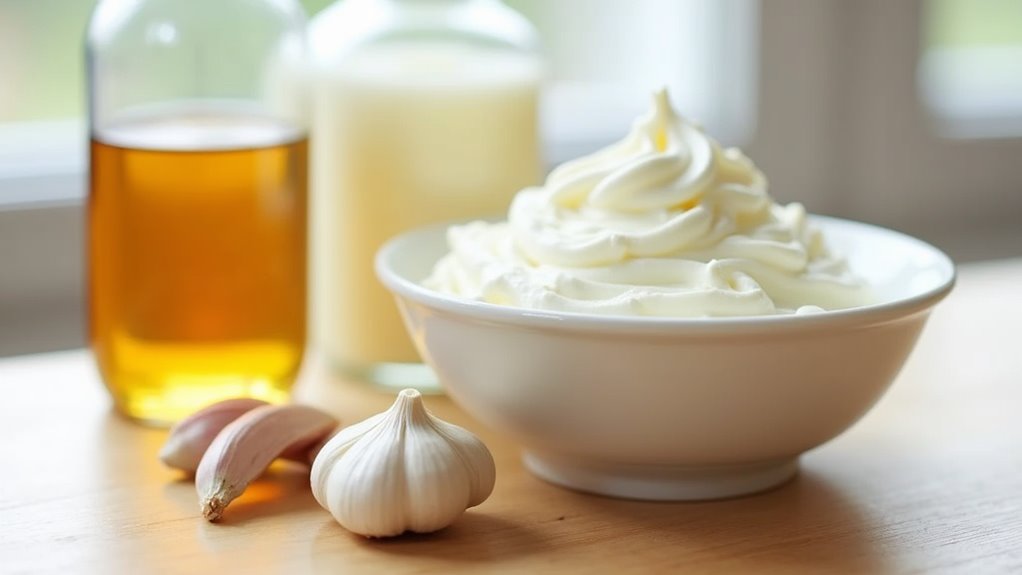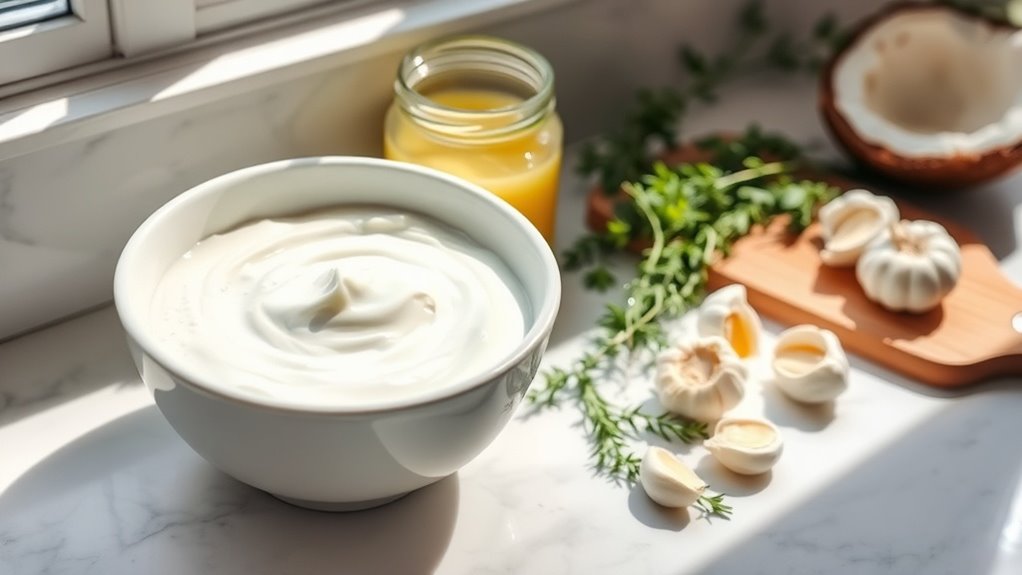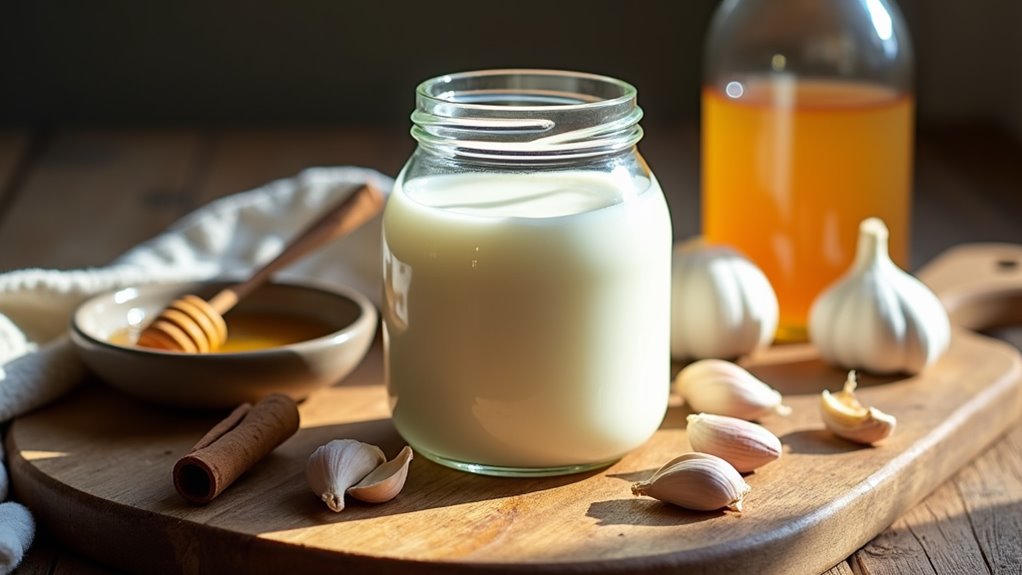Yeast Infection Remedies That Help Fast (Without a Doctor Visit)
You can treat a mild yeast infection at home using over-the-counter antifungal medications like Monistat or Vagistat-1 for quick relief. Natural remedies include applying tea tree oil mixed with coconut oil externally and taking probiotic supplements. Keep the area dry, wear cotton underwear, and avoid sugar and yeast-containing foods while healing. If symptoms are severe or persist after 7 days, seek medical care. Learn proven strategies to prevent future infections below.
What Causes Yeast Infections to Develop
While the human body naturally contains small amounts of Candida fungi, yeast infections develop when there’s an overgrowth of these organisms, particularly Candida albicans.
You’re more likely to experience this overgrowth when taking antibiotics, having high blood sugar, or dealing with a weakened immune system.
Other triggers include hormonal changes during pregnancy, using hormone-based birth control, or wearing damp, tight-fitting clothes.
Before seeking fast yeast infection remedies, it’s important to understand that stress, lack of sleep, and poor diet can also disrupt your body’s natural balance, creating conditions where yeast thrives.
Common symptoms include intense vaginal itching accompanied by burning sensations, unusual discharge, and redness in the affected area.
Common Symptoms to Watch For
When your body experiences a yeast infection, several distinct symptoms typically develop that can help you identify the condition.
Recognizing these warning signs early allows you to seek appropriate treatment and find relief faster.
-
You’ll notice intense itching and burning around the vaginal area, which often becomes more severe at night or after urination.
-
A thick, white, cottage cheese-like discharge appears, usually without a strong odor.
-
The vulva and surrounding tissue may become red, swollen, and tender to touch, sometimes developing small tears or cracks in the skin.
Women taking birth control pills may experience more frequent yeast infections due to hormonal changes in their bodies.
Essential Oil Treatments That Work
Many women seeking natural alternatives to conventional yeast infection treatments have found relief through specific essential oils.
Tea tree oil contains powerful antifungal properties that can help combat Candida growth when properly diluted. Mix 3-5 drops with a carrier oil like coconut oil before applying.
Other effective options include oregano oil, which studies show may inhibit yeast, and lavender oil for its soothing properties.
Always perform a patch test first and don’t insert essential oils internally. For best results, apply twice daily to the external affected area using a cotton pad until symptoms improve.
Clove oil provides natural pain relief while fighting fungal infections in the affected area.
Dietary Changes to Fight the Infection
Your diet plays a crucial role in managing yeast infections by directly impacting the growth of Candida albicans in your body.
You’ll need to drastically reduce your sugar consumption and eliminate foods containing yeast, such as beer, bread, and vinegar-based products, since these can feed the infection.
Adding probiotic-rich foods like yogurt, kefir, and fermented vegetables to your daily meals can help restore your body’s natural balance of beneficial bacteria while fighting the overgrowth of yeast.
Cut Sugar Intake
Since yeast thrives on sugar, reducing your sugar intake plays a crucial role in fighting candida infections. Your body’s natural balance can be restored by limiting foods that feed the yeast overgrowth.
-
Cut out refined sugars, including candy, sodas, and baked goods, which can spike blood sugar and fuel yeast growth.
-
Avoid hidden sugars in processed foods, condiments, and flavored yogurts that can sabotage your recovery.
-
Replace high-sugar fruits with low-glycemic options like berries and green apples while limiting natural sweeteners such as honey and maple syrup.
Add Probiotic Foods
Beneficial probiotic foods can help restore the balance of good bacteria in your digestive system and fight off yeast overgrowth. Add yogurt with live cultures, kefir, kimchi, sauerkraut, and kombucha to your daily diet.
These fermented foods contain Lactobacillus acidophilus and other helpful bacteria that combat Candida albicans.
Look for plain, unsweetened yogurt specifically labeled with “live” or “active” cultures. Consume at least one serving daily.
If you’re dairy-sensitive, try coconut yogurt or other non-dairy fermented alternatives. These probiotic-rich foods work best when combined with your reduced sugar intake to effectively combat the infection.
Avoid Yeast-Heavy Foods
While fighting a yeast infection, it’s crucial to limit or eliminate foods containing high amounts of yeast and fermented ingredients that can feed Candida growth.
Your diet plays a significant role in managing the infection and preventing future outbreaks.
-
Avoid bread products made with baker’s yeast, including pastries, rolls, and pizza dough – opt for sourdough or yeast-free alternatives.
-
Skip fermented foods like kombucha, sauerkraut, and kimchi during the active infection phase.
-
Cut out aged cheeses, alcoholic beverages, and nutritional yeast supplements until symptoms improve.
These dietary changes can help reduce the yeast population and support your body’s natural healing process.
Natural Probiotic Solutions
As research continues to demonstrate the effectiveness of probiotics against vaginal yeast infections, natural solutions have gained significant attention in clinical practice.
You’ll find powerful probiotic support in fermented foods like Greek yogurt, kefir, and kimchi. These contain beneficial bacteria that help restore your vaginal flora balance.
For targeted relief, consider probiotic suppositories containing Lactobacillus strains, which studies show can effectively combat Candida overgrowth.
Don’t forget to incorporate prebiotic-rich foods like garlic, onions, and asparagus. These feed beneficial bacteria, enhancing their ability to fight yeast infections.
Regular consumption of these natural probiotics can help prevent future infections.
Studies show that adding raw honey’s antimicrobial properties can enhance the effectiveness of probiotic treatments when used as directed.
Over-the-Counter Treatment Options
Several effective over-the-counter antifungal medications can treat vaginal yeast infections within 1-7 days. These medications come in various forms, including creams, suppositories, and tablets, all containing active ingredients that target Candida fungi.
-
Miconazole (Monistat) comes in 1-day, 3-day, or 7-day treatment options and includes an external cream for itch relief.
-
Clotrimazole (Gyne-Lotrimin) offers 7-day treatment with both internal and external applications.
-
Tioconazole (Vagistat-1) provides single-dose treatment but may cause more initial irritation than multi-day options.
Choose shorter treatments for convenience, but longer courses may be gentler and more thorough.
When to Seek Medical Help
If you experience severe pain, fever above 101°F, or unusual discharge that’s greenish or has a foul odor, seek immediate medical attention as these are emergency warning signs of a potentially serious condition.
You should also consult your healthcare provider if you’ve had more than four yeast infections in the past year, as recurring infections may indicate an underlying health issue.
Watch for symptoms that persist despite over-the-counter treatment, especially if you’re diabetic or immunocompromised, since these conditions can complicate yeast infections.
Emergency Warning Signs
While many yeast infections can be treated at home, certain symptoms require immediate medical attention.
If you experience any of these emergency warning signs, don’t delay seeking professional care.
-
High fever (over 101°F/38.3°C) accompanied by severe pelvic pain, as this could indicate a serious infection that’s spread beyond the vaginal area.
-
Unusual discharge that’s greenish, grayish, or has a strong fishy odor, which may signal a different type of infection requiring specific treatment.
-
Rashes, blisters, or severe itching that spreads to other parts of your body, possibly indicating an allergic reaction or more serious condition.
Recurring Infection Red Flags
Recognizing when recurring yeast infections warrant medical attention can prevent more serious complications. If you’ve experienced four or more infections within a year, it’s crucial to consult a healthcare provider.
| Red Flag | What to Watch | When to Act |
|---|---|---|
| Frequency | 4+ infections/year | Immediate medical visit |
| Response | No improvement after OTC | Within 7 days |
| Symptoms | Severe pain/swelling | Within 24 hours |
| Risk Factors | Diabetes/pregnancy/HIV | Before self-treating |
| Different | Unusual discharge/smell | Within 48 hours |
Remember that frequent infections might indicate an underlying condition, compromised immune system, or resistant strain requiring prescription-strength treatment.
Prevention Tips and Best Practices
Although yeast infections are common, several preventive measures can significantly reduce your risk of developing them.
Maintaining proper vaginal health requires consistent attention to daily habits and lifestyle choices that create an environment where harmful yeasts can’t thrive.
-
Keep your genital area dry and clean by changing out of wet swimsuits or sweaty clothes promptly, using unscented products, and wearing breathable cotton underwear.
-
Avoid douching, scented feminine products, and tight synthetic clothing that can disrupt your natural pH balance.
-
Maintain a healthy immune system through proper nutrition, stress management, and limited sugar intake.
Consider incorporating probiotic-rich foods like yogurt, kefir, and kimchi into your diet to support optimal gut health and combat Candida overgrowth.
Lifestyle Habits That Speed Recovery
When you’re recovering from a yeast infection, it’s crucial to change out of damp swimwear or sweaty workout clothes immediately to prevent creating the warm, moist environment that yeast thrives in.
You’ll want to incorporate probiotic-rich foods like yogurt, kefir, and fermented vegetables into your daily diet to help restore your body’s natural balance of beneficial bacteria.
These dietary changes, combined with staying dry, can significantly accelerate your healing process while reducing the likelihood of recurrence.
Stop Wearing Wet Clothes
Since moisture creates an ideal environment for yeast growth, you shouldn’t stay in wet or damp clothing after swimming, exercising, or sweating. Changing into dry, clean clothes promptly helps prevent yeast overgrowth in your intimate areas.
-
Change out of wet swimsuits within 15 minutes after leaving the pool or beach.
-
Swap sweaty workout clothes for fresh, dry ones immediately after exercise.
-
Keep an extra set of underwear with you to change if you’ve been perspiring heavily during the day.
Choose breathable, moisture-wicking fabrics like cotton for your underwear to maintain proper airflow and reduce moisture buildup.
Boost Probiotic-Rich Foods
Beyond maintaining dry, clean clothing, your dietary choices play a key role in fighting yeast infections. Load up on probiotic-rich foods like yogurt, kefir, sauerkraut, and kimchi to restore your body’s beneficial bacteria.
These foods help maintain a healthy vaginal pH and combat Candida overgrowth. Look for yogurt containing live cultures of Lactobacillus acidophilus, which studies show can reduce yeast infection symptoms.
Aim for at least one serving of fermented foods daily. You’ll also want to limit sugar and refined carbs, as they can feed yeast growth and slow your recovery.
Myths and Facts About Yeast Infections
Despite widespread awareness of yeast infections, numerous misconceptions persist about their causes, treatments, and prevention. Understanding the facts helps you make informed decisions about your vaginal health and treatment options.
-
Wearing tight clothes or underwear doesn’t directly cause yeast infections, but it creates a warm, moist environment where yeast thrives.
-
Men can get yeast infections, though they’re less common than in women.
-
Taking antibiotics increases your risk of developing a yeast infection by disrupting your body’s natural bacterial balance, but antibiotics don’t directly cause the infection.
A cottage cheese discharge is one of the most reliable indicators of a yeast infection, unlike other vaginal conditions that may have different discharge characteristics.
